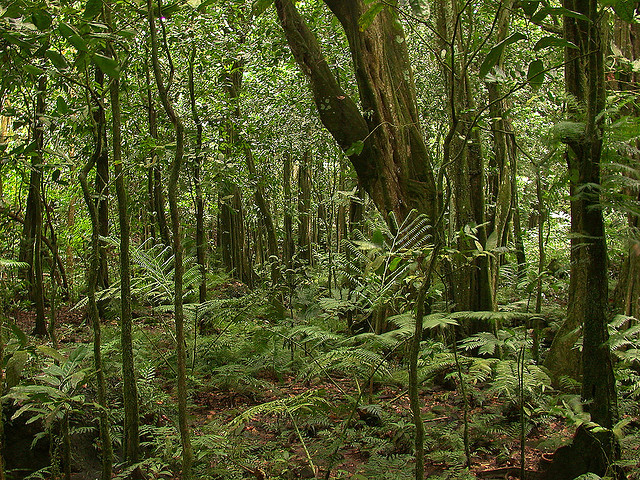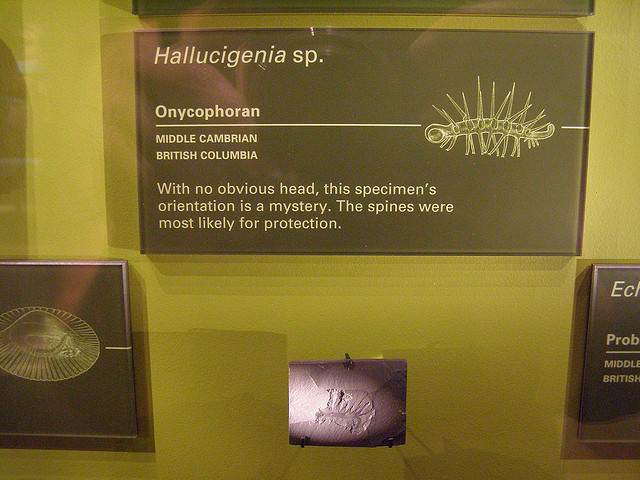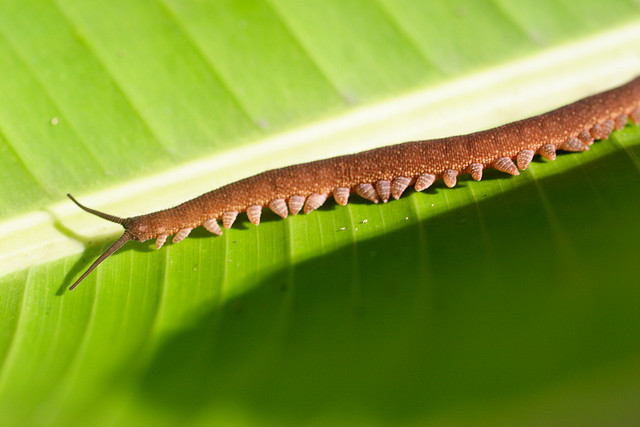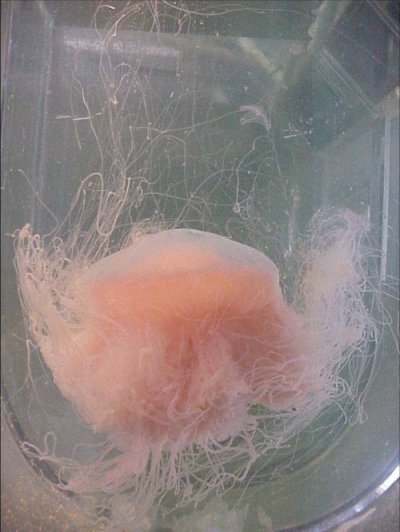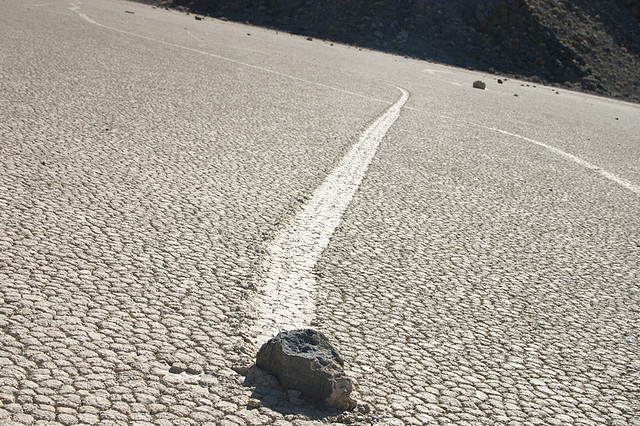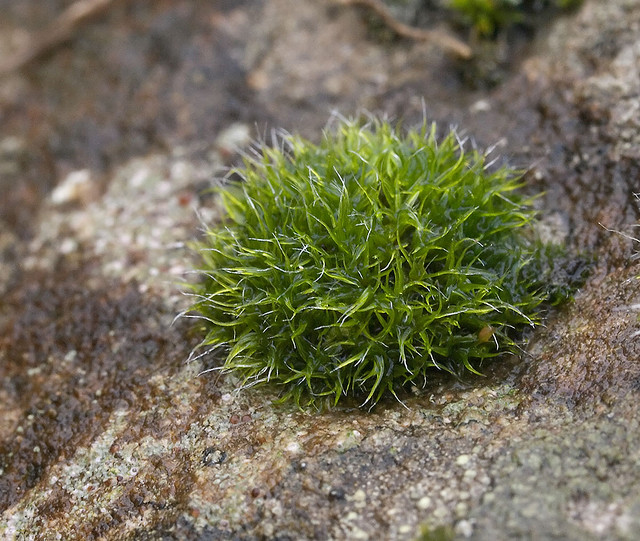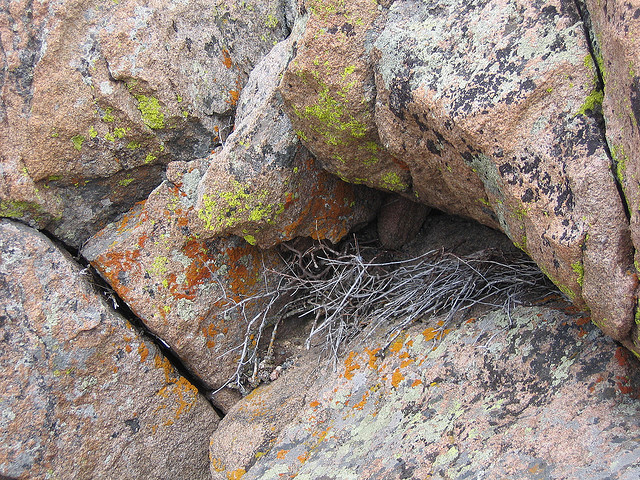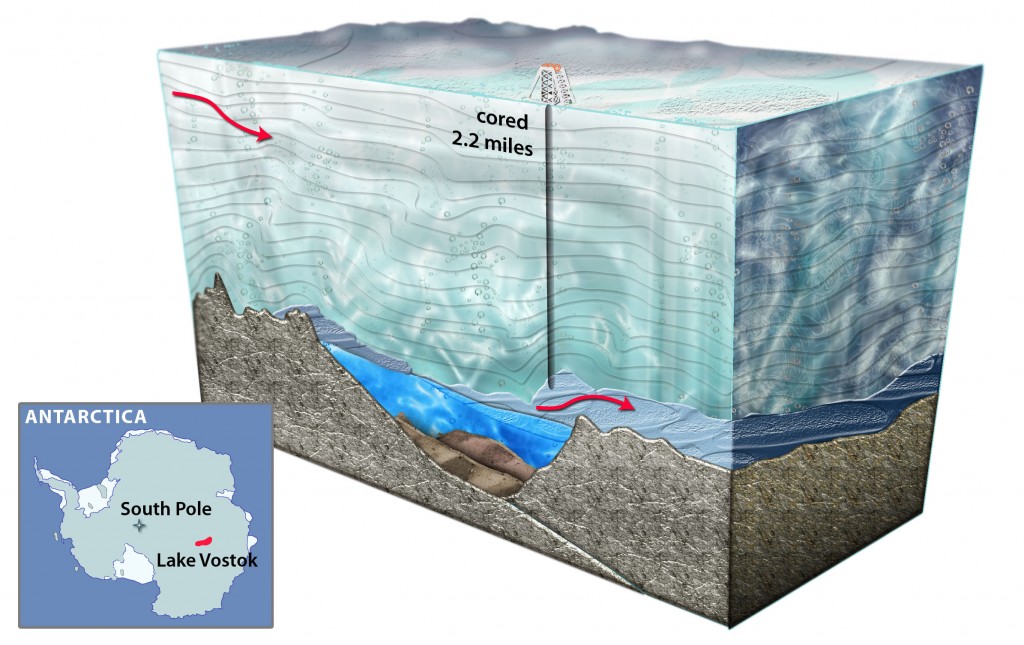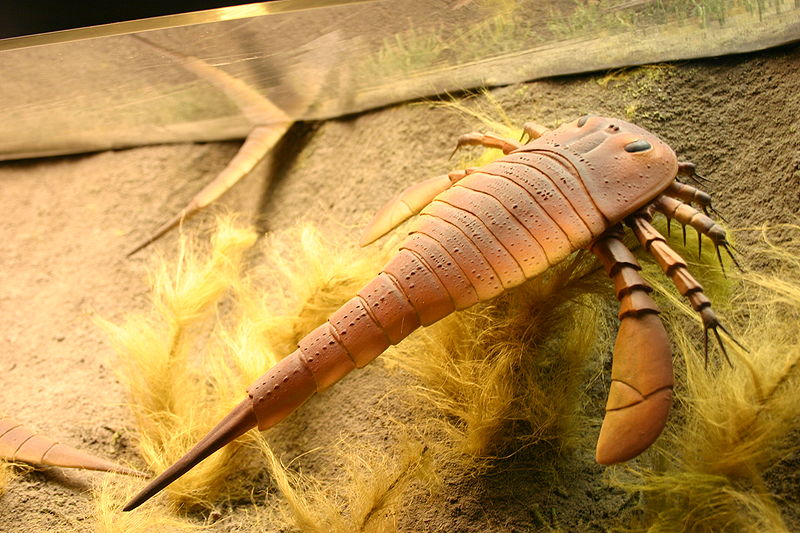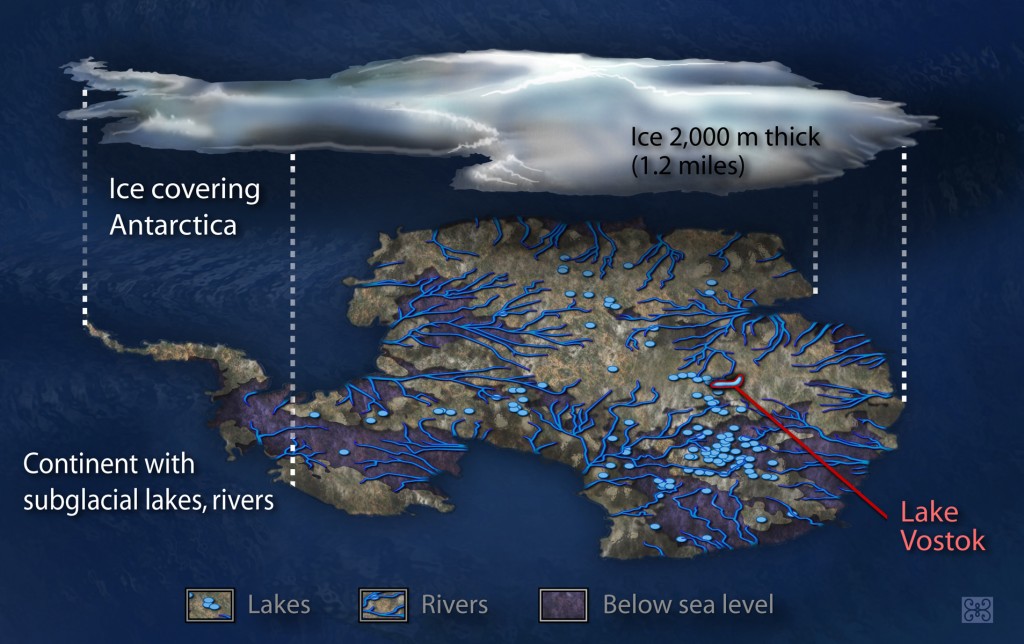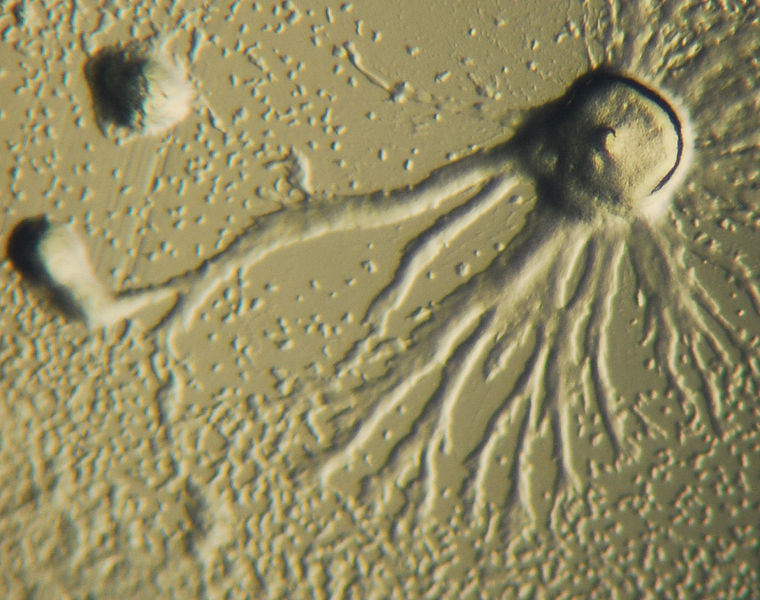
You are witnessing one of nature's most incredible migrations that never gets shown on the Discovery Channel. Believe it or not, each one of those little dots is a solitary amoeba. But not for long.
Note: This post contains a prize inside! It will await those patient enough to dig to the bottom. : )
Regular readers of this blog know well about my weakness for the protists formerly known as slime molds (scientists know apparently prefer the more PC and sexy “social amoebae”, although how you can get much sexier than “slime mold” I really don’t know). Exciting news came this past week that a species of cellular slime mold — Dictyostelium discoideum — contains members who have taken up bacterial farming (or at least husbandry — more on that distinction later). I ask again — slime molds: is there anything they can’t do*?
Before we get into their new status as potential FFA members, let’s talk a little bit about this particular group of slimes. So far on this blog, I’ve told you primarily about a group informally called “plasmodial slime molds”. This is the kind that make big, colorful slimy slicks that rove the forest floor wreaking microbial havoc as they vacuum up any bacteria, yeasts, and protists in their path, and then blossom into beautiful bright fruiting bodies like the one in the masthead of this blog.
But there is another kind of slime mold. One that, while perhaps less glamorous, is even more crafty and incredible: the dictyostelids, or cellular slime molds. What is the difference? Well, if plasmodial slime molds are amoebas that discovered living large, cellular slime molds are amoebas that discovered living social. In a plasmodial slime mold (also called myxomycete or myxogastrid), two amoebae meet, decide to spend the rest of their lives together, fuse, and then that fused cell starts dividing mitotically, or asexually, like it’s going out of style to churn out hundreds or thousands of genetically identical nuclei inside one big happy bag of cytoplasm.
In a cellular slime mold, something even more remarkable happens: a single amoeba called a myxamoeba suddenly decides it is starving. As a result, it secretes a molecule called cAMP as a distress call**. And suddenly, hundreds, thousands, hundreds of thousands of amoebae amplify the call by emitting their own cAMP, and begin streaming in toward Amoeba Zero in pulsating waves. They get sticky, climb on top of each other, and cling together. The pile towers up. And then, if it’s not sufficiently bright enough, the tower topples and begins sliming around like a slug. It’s now a single multicellular organism — made of 10,000 to 125,000 amoebae who still retain their individual membranes and identities. Yes, like the Borg — if they were all crazy-glued together. And if they intermittently all lived happily on their own before feeling an irresistible pull to join something called a “collective”.
Take a look at this process:
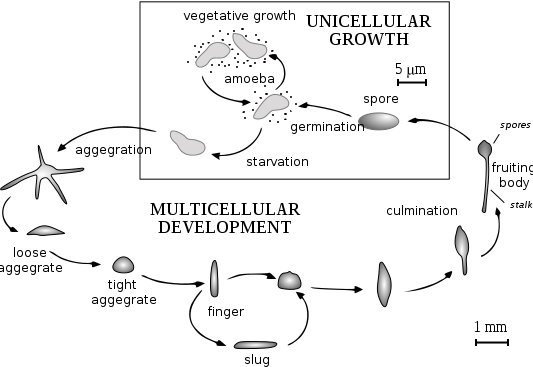
That aggregation star at left is a schematic of what you're seeing in the image at the top of this page. Tijmen Stam, IIVQ (SVG conversion) - user:Hideshi (original version) GFDL + CC-BY-SA, click image for link.
After crawling far enough to reach an area deemed suffienctly light (I imagine this it to raise the odds of being in a windy, spore-dispersally spot), the slug coalesces into a sombrero-shaped mass from which some of the cells begin gliding upward along a stalk like an elevator. At the apex, the elevator cells convert themselves to spores. Ultimately, they blow away in the breeze to (hopefully) more bacterial pastures.
Now take a look at this process in action.
- First, here’s an overview from my alma mater — the Plant Pathology department at Cornell (Try the downloadable versions if the player doesn’t automatically load or if you want to watch a high-res version (recommended)). Watch the perimeter and the background. Note slugs wandering about looking lost.
And it gets better — or worse, depending on your perspective. Some of the amoebas in the slug must voluntarily sacrifice themselves (a process called programmed cell death, or apoptosis. It’s basically microbe seppuku) to form the long stalk. This seems to be determined primarily by what phase of the cell cycle they were in when they reached the forming slug; the last cells to arrive will form the tail of the slug, and the early-arrivers at the head of the slug will become the sacrificed cells of the stalk.
But in an entity where not all cells are genetically identical, you can see how it might be tempting (and much more reproductively successful) to shirk stalk duty and climb your way to the top come hell or high water — that is, to cheat. And in fact, it turns out cellular slime mold myxamoebae do sometimes cheat their way to reproductive success. Scientists fascinated by this have studied it a lot.
That brings us back to farming. Because in addition to being cheaters, some Dictyostelium also appear to plan ahead in other ways. Like packing lunch — or perhaps the seed of lunch. They bring their preferred bacteria with them and seed the soil where their spores land. It’s a little too early to tell if they just eat what they brought or wait sufficiently long for what they brought to reproduce a bit. But the evidence so far seems pretty conclusive: some D. discoideum spores are packin’ bacteria. Though whether they are packin’ them inside or outside the spore wasn’t entirely clear to me either. Only 1/3 of the samples they tested were farming amoebae, but that may be because it does come with a price. Farming amoebae are fitter in times of starvation, but less competitive than non-farmers in times of plenty. Having both strains around makes sense in a world of changing conditions.
Because they don’t weed, water, or fertilize their future food, some scientists suggest it might be better termed husbandry than farming. Whatever you call it, these are the first microbes ever known to do it. Cool***. And the reason, scientists told National Geographic, is that these are also the only microbes that are social — being social enables wind-blown, stalk-borne dispersal, which makes bringing bacteria worth it at all. And so far as we know, all the planet’s other farmers are all social organisms as well. EEEN-teresting.
From Science magazine’s writeup:
Koos Boomsma, an evolutionary biologist at the University of Copenhagen who did not work on the study, is not surprised that farming is scattered through the tree of life. “But if I would’ve had to predict where I would have next expected farming to be discovered, I would never have predicted a slime mold,” he says.
See, this is exactly what happens when we underestimate slime molds. And you all thought I was kidding about that world domination thing . . .
This discovery got full court press coverage; you can read more about it here, here, here, here, here, and here.
When first discovered, slime molds — both plasmodial and cellular — were thought to be fungi, hence the “mold” bit. But unlike fungi, they have cellulose cell walls (like plants and some other protists, but not chitin, like fungi) and cellular organelles called centrioles (like animals). Moreover, the two groups were not thought to be closely related to each other****. Now we know that although there are other types of slime molds that do not fit into these two groups, the plasmodial and cellular slime molds are true taxonomic groupings reflecting common ancestry, and that the two groups are fairly closely related: they are both in the same taxon as free-living amoebas — the Amoebazoa (look for the group on this tree, and then click on it to explore. Notice on the big tree they’re on the same branch with animals and fungi). Which makes sense — slime molds all begin life as ordinary looking amoebas.
Now bear in mind Dictyostelium, for all its transcendent coolness, is but one species among many — perhaps hundreds or thousands. What are other cellular slime molds like? Well, we may not know what many or most of them are like, since so few people study them. But below are videos (your treat for making it all the way to the end of this post) of a spectacularly beautiful other species of cellular slimes, Polysphondylium violaceum (Paul-ee-sfon-dil’-ee-um vie-o-lace’-ee-um — say that three times fast). Unlike Dictyostelium, it does not make roving slugs (though it does aggregate), and it uses a chemical called glorin, and not cAMP, as its chemoattractant. Watch the complex fruiting bodies — or sporocarps — form in these time-lapse movies again from my old buds in the Plant Path department at Cornell. Notice in particular the branching and the purple pigment — it’s like a fireworks display in slow motion. Try pausing the videos just before the end for a nice still. And again, try the downloadable versions — they’re much higher quality images anyway.
- Video 1 — close up
- Video 2 — wider angle, different sample, even more spectacular display
Yes. Ameobas can do that.
Finally, ponder this: Dictyostelium, and the cellular slime molds as an entire group — was not discovered until 1935 in a North Carolina forest. 1935. Now ponder all the other amazing stuff that must still be out there, just waiting.
____________________________________________________________________
*Perhaps home decorating.
**cAMP is a ubiquitous Earth signaling protein found in organisms from humans to bacteria. It’s a stripped down ATP ( the energy currency of the cell) used, essentially, as one of several master switches for turning circuits (metabolic pathways) on and off in the bioreaktor/ Brownian chaos computer of the cell (Many, if not most, of the biochemical reactions of the cell are governed merely by the rate at which molecules happen to randomly bump into one another (implication: more molecules will make the reaction go faster). Even proteins chaperoned to important reactions by other proteins must bump into their chaperones in the first place.) In social amoebae, cAMP takes up the somewhat novel role of chemical attractant — that is, a pheromone.
***There are a few more lurid and/or fascinating bits to the cellular slime mold story. For one, lest you think their asexual reproduction was the only weird thing about them, Dictyostelium sex is also kinda creepy. It starts out normally: two amoebae meet and fuse. But things get weird fast: the zygote (diploid, or double-chromosomed) offsprings goes on a cannabilistic rampage, engulfing all nearby amoebae as fast as it can. When sated, the cell wall thickens with cellulose to form the resting spore, or macrocyst, that can survive tough conditions. Before it germinates, the cell undergoes meiosis, or reductive cell division, to get back to one copy of chromosomes per cell, and then several mitotic, or regular, cell divisions before it releases its little myxamoebas when conditions are good.
**** From my late-90s botany book: “The plasmodial slime molds, or myxomycetes, are a group of about 700 species that seems to have no direct relationship to the cellular slime molds, the fungi, or any other group.”

